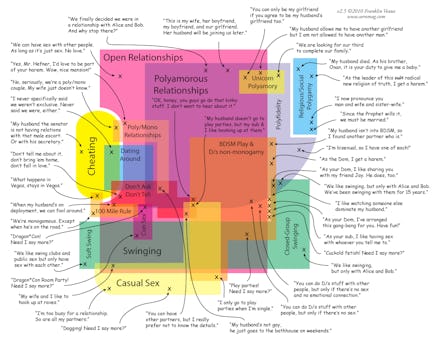One Epic Chart Proves There's No Right Way to Be in a Relationship

What kind of relationship do you have?
It may seem like perplexing question — there are different kinds? But in fact, in an era of the growing acceptance of casual sex, a better understanding of polyamory and a curiosity about open relationships, there has never been more freedom and opportunity to figure out what works for you.
Because, as one epic chart shows, the kind of relationship that works for one person may not be the kind that works for someone else.
Settling with one person isn't the only way: The chart, designed in 2010 by polyamory and BDSM activist Franklin Veaux and recently shared by sex researcher and New York University professor Zhana Vrangalova, demonstrates how much more complicated and nuanced the options are.
"It's a great reminder that there are different strokes for different folks and no one relationship constellation that works from everyone," Vrangalova told Mic.
The idea for the chart came to Veaux when someone asked him why we even need the word "polyamory," when it seemed like a synonym for open relationships and swinging, he told Mic. "This idea seems to assume that there's really only one kind of non-monogamy, which is kind of silly," Veaux writes in a blog post on Xeromag.
The chart helps give voice to myriad intersecting relationship structures out there. There's the "100-Mile Rule," which the chart expresses as "We're monogamous. Except when he's on the road." Or the closed-group swinging set, which can be explained as "We like swinging, but only with Bob and Alice." (Then, of course, there's non-monogamy without communication or consent, otherwise known as cheating.)
Still not totally "normal": A 2012 study from the University of Michigan, which estimated that 4% of individuals identify as consensually non-monogamous, found that bias against non-monogamous relationships remains in the form of pro-monogamy stances. Without prompting, the study's participants agreed that monogamy had wide-ranging benefits for relationships, sexual health, the individual, the family and society at large, "suggesting the existence of a halo effect surrounding monogamy and monogamous relationships," the study concluded.
It's no surprise that we see the value in monogamy, considering those are the most common relationships we see in rom-coms and TV, not to mention our own lives. Despite the challenges that monogamous commitment presents, a Huffington Post and YouGov survey found that only 15% of Americans age 18 to 29 would ever consider being in an open relationship.
That's a fine decision, should monogamy be your ideal choice. Monogamy has an evolutionary benefit of determining paternity and can provide stability and wellness to partners who choose it. "I think that monogamy can be logistically easy, but I don't think it's objectively superior," dating consultant Steve Dean told Mic.
Defining your own comfort zone: Openly non-monogamous couples, in fact, are more likely to engage in safe sex than "unfaithful individuals," one study found. And non-monogamous couples can be just as securely attached to their partners as others.
"We're trying to apply a one-size-fits-all relationship structure to every single person, and everyone's different," said Dean. "[Polyamory] is a fully empowering way of picking a structure that works best for you and your specific partner or partners."
Plus, if we're being honest, many of us are already engaged in non-monogamy in the form of casual dating that falls somewhere between "someone I just sleep with" and "someone I'm committed to forever." There's lots of gray — or as the chart suggests, rainbow-colored — area in between.
As sex columnist Dan Savage, a proponent of "monogamish" relationships, told the New York Times, "there's not a one-size-fits-all way" to approach a relationship, monogamous or otherwise. There's no guarantee of what's going to fulfill one person most, and no two relationships that look the same.
March 31, 2015, 3:16 pm: This post has been updated.